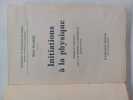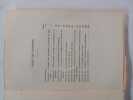-
Type
Art print (2)
Autograph (1)
Book (33001)
Magazine (147)
Manuscript (3)
Maps (1)
Photographs (8)
-
Latest
Last 24h (2)
Last 3 days (123)
Last month (301)
Last week (11)
-
Language
Chinese (1)
Dutch (2)
English (106)
French (32912)
German (10)
Greek (1)
Italian (112)
Japanese (1)
Latin (5)
Polish (2)
Portuguese (4)
Russian (3)
Spanish (3)
Swedish (1)
-
Century
16th (33)
17th (75)
18th (569)
19th (4356)
20th (12135)
21st (1830)
-
Countries
Belgium (6544)
Brazil (15)
Canada (13)
Côte d'Ivoire (30)
Denmark (146)
France (25178)
Germany (8)
Greece (3)
Netherlands (1)
Switzerland (1225)
-
Syndicate
ALAC (13)
CLAQ (5)
CNE (20)
ILAB (14115)
NVVA (516)
SLACES (515)
SLAM (13375)
SNCAO (64)
Einfuhrung in die theorie der Wärme zum gebrauch bei vorträgen sowie zum selbstunterricht
Leipzig, Hirzel, 1932, un volume in 8 relié en cartonnage éditeur, 6pp., (1), 251pp., 7 figures
---- Deuxième édition - DSB XI pp. 7/17**4189/L7AR
Electromagnétisme traduit de l'allemand par E. Labin -- PREMIERE EDITION FRANCAISE
P., Alcan, 1939, un volume in 8, broché, 14pp., 448pp.
---- PREMIERE EDITON FRANCAISE ---- "M. Planck, (1858/1947), applique le concept d'entropie à l'interprétation de certains phénomènes physico-chimiques et thermoélectriques. En 1897, il publie un manuel de thermodynamique qui servira pendant plus de trente ans de texte de référence. En 1889, il entreprend l'étude des conditions d'équilibre thermique du rayonnement électromagnétique... Le 14 Décembre 1900, il présente sa théorie à la Société allemande de physique. Ce jour peut être considéré comme la date où est posée la première pierre de la théorie quantique... Son nom est attaché à la constante fondamentale qui intervient dans les phénomènes quantiques. Il reçut le Prix Nobel de physique en 1918 ---- DSB XI**CAV.F2(2)-4190/M2-CAV.E4
Leçons de thermodynamique avec une conférence du même auteur à la Société chimique de Berlin sur le théorème de Nernst et l'hypothèse des quanta -- PREMIERE EDITION FRANCAISE
P., Hermann, 1913, un volume in 8 relié en demi-chagrin rouge (reliure de l'époque), (plats légèrement défraichis), (2), 310pp., (1)
---- PREMIERE EDITION FRANCAISE -- BON EXEMPLAIRE -- Notes au crayon dans les marges et interlignes**4194/M2
AUTOBIOGRAPHIE SCIENTIFIQUE ET DERNIERS ECRITS .
Editions Albin Michel, 1960, traduction, préface et notes par André GEORGE, broché, 224pp. bon état, 204x133 . (p3)
Phone number : 33 05 49 26 70 36
Autobiographie scientifique. et derniers écrits
Albin Michel, coll. « Les savants et le monde » 1960 In-8 broché. 220 pages. Bon état d’occasion.
Bon état d’occasion
Autobiographie scientifique et derniers écrits. Introduction, traduction et notes d'André George.
P., Albin Michel (Collection "Les Savants et le Monde"), 1960, in 8° broché, 221 pages ; couverture illustrée.
...................... Photos sur demande ..........................


Phone number : 04 77 32 63 69
Electromagnétisme.
Félix Alcan. 1939. In-8. Broché. Etat d'usage, 2ème plat abîmé, Dos abîmé, Intérieur acceptable. XIV + 448 pages - 2ème plat désolidarisé - coiffes abîmées.. . . . Classification Dewey : 500-SCIENCES DE LA NATURE ET MATHEMATIQUES
Traduit de l'allemand avec notes et compléments par Ed.Labin. Classification Dewey : 500-SCIENCES DE LA NATURE ET MATHEMATIQUES
Initiation à la physique. Traduit de l'allemand par J. du PLESSIS DE GRENEDAN.
P., Flammarion (Collection "Bibliothèque de Philosophie scientifique"), 1942, in 8° broché, 279 pages ; couverture réparée au scotch.
PHOTOS sur DEMANDE. ...................... Photos sur demande ..........................


Phone number : 04 77 32 63 69
L’image du monde dans la physique moderne
Editions Gonthier, coll. « Bibliothèque Mediations » 1963 In-12 broché 17,5 cm sur 11. 156 pages. Rhodoïd rouge. Bon état d’occasion.
Bon état d’occasion
L'IMAGE DU MONDE DANS LA PHYSIQUE MODERNE / COLLECTION MEDIATIONS
GONTHIER. 1963. In-12. Broché. Etat d'usage, Couv. convenable, Dos satisfaisant, Intérieur acceptable. 156 pages. . . . Classification Dewey : 500-SCIENCES DE LA NATURE ET MATHEMATIQUES
Classification Dewey : 500-SCIENCES DE LA NATURE ET MATHEMATIQUES
Initiations à la physique
Flammarion, coll. « Bibliothèque de philosophie scientifique » 1941 In-12 broché 19,4 cm sur 13. 278 pages. Couverure légeremet décirée interieur frais sinon état correct d’occasion.
Etat correct d’occasion
Vorlesungen über die Theorie der Wärmestrahlung. Fünfte (5.), abermals umgearbeitete Auflage.
Leipzig, Johann Ambrosius Barth, 1923, gr. in-8°, IX + 221 S., mit 6 Abbildungen, Original-Leinenband.
Poggendorff III/1046-7 and IV/1172-3; Dictionary of Scientific Biography XI/7-17.

(SLACES, NVVA)
Phone number : 41 (0)26 3223808
Early Louis Sullivan Building Photographs
, William K Stout Pub, 2001 Hardcover with dusjacket, + slipcase, in-folio 39x32cm. Illustrated allfords large-format reproductions of 125 b&w images of early buildings designed by Louis Sullivan. ISBN 9780970973115.
The photographs were made with care by Sullivan's photographers in close collaboration with him, using large view cameras, hand-ground lenses, and special films. For more than 40 years, Crombie (1914-1999) championed the photographs as the primary means for understanding Sullivan's work. In a collaborative effort, he and Plank (U. of Virginia) prepared an exhibit in 1991; and then, although Crombie felt that the photographs speak more than words could ever convey, Plank undertook investigation of the photographers and the provenance of the photographs, as well as preparation of interpretive text.
La Métempsycose ou observations sur ce système.-
Par les Sieurs Blugeon apprenti-menuisier, et Gaboir manuvre-maçon. Scène populaire dédiée à leur ami Eugène Isabey par Jaime & Ch. Plantade. Paris. Alexandre Cotelle. s.d. (1°moitié du XIX°). 4pp. in-f° (27x34cm), lithographiées, 1°page ornée d'une vignette représentant les auteurs sur les lieux de leur travail, non signée (Isabey?).
Amusant dialogue entre les deux ouvriers.|Charles-François Plantade (1787-1870) est connu pour ses amusantes productions à l'époque de la Restauration et de la Monarchie de Juillet. (Fétis 2°supplément, p.351 ne signale pas notre chanson). La chanson du menuisier et du maçon.
BIOLOGIE CELLULAIRE ET VEGETALE
BELIN EUGENE. 1946. In-8. Relié. Etat d'usage, Couv. convenable, Dos frotté, Intérieur frais. VI + 934 pages - quelques pages abimées en tête sur la table des matieres de la pages 925 à 934.. . . . Classification Dewey : 500-SCIENCES DE LA NATURE ET MATHEMATIQUES
Classification Dewey : 500-SCIENCES DE LA NATURE ET MATHEMATIQUES
BIOLOGIE CELLULAIRE ET VEGETALE A L'USAGE DES CANDIDATS AU P.C.B. - etude morphologique de la cellule, etude physicochimique de la cellule, etude physiologique de la cellule, la biologie vegetale, la morphologie des plantes superieures, la morphologie...
BELIN EUGENE. 1963. In-8. Relié. Bon état, Couv. convenable, Dos satisfaisant, Intérieur frais. VI + 934 pages - nombreuses illustrations en noir et blanc dans et hors texte - 1 etiquette collée sur le 1er plat et au dos - 1 etiquette et 1 tampon sur la page de titre - 2 tampons au dos de la page de titre et sur la page 934 - 1 tampon sur la page VI.. . . . Classification Dewey : 500-SCIENCES DE LA NATURE ET MATHEMATIQUES
Sommaire: etude morphologique de la cellule, etude physicochimique de la cellule, etude physiologique de la cellule, la biologie vegetale, la morphologie des plantes superieures, la morphologie des plantes superieures, organes de reproduction, la physiologie des plantes superieures, organes vegetatifs... Classification Dewey : 500-SCIENCES DE LA NATURE ET MATHEMATIQUES
COURS DE BIOLOGIE CELLULAIRE ET VEGETALE, A L'USAGE DES CANDIDATS AU PCB
Belin. 1942. In-8. Relié. Etat d'usage, Couv. partiel. décollorée, Dos fané, Intérieur acceptable. 934 pages. Illustré de nombreuses gravures en noir et blanc dans le texte. Quelques annotations au crayon rouge dans le texte.. . . . Classification Dewey : 570-Sciences de la vie
2e édition. Etude morphologique de la cellule. Etude physicochimique de la cellule. La biologie végétale. La morphologie des plantes supérieures... Classification Dewey : 570-Sciences de la vie
Fondements d'une théorie florale nouvelle. L'ontogénie de la fleur -- EDITION ORIGINALE
P., Masson, 1949, un volume in 8, broché, (2), pp. 34/186
---- EDITION ORIGINALE ---- La théorie de la métamorphose et ses contradicteurs : De Goethe à nos jours, contre la théorie de la métamorphose - La disposition florale d'après les adversaires de la métamorphose (dans l'oeuvre de Grégoire, de Thompson) - La théorie des hélices foliaires multiples et de la contiguité - L'interprétation de la fleur et la paléontologie - ETC**4195/A7AR
LA CELLULE VEGETALE- BIOLOGIE CELLULAIRE
BELIN. 1937. In-8. Broché. Etat d'usage, Couv. partiel. décollorée, Dos satisfaisant, Intérieur frais. 264 pages- nombreuses figures en noir et blanc dans le texte. . . . Classification Dewey : 570-Sciences de la vie
Classification Dewey : 570-Sciences de la vie
Kinésithérapie active - exercices thérapeutiques 2 volumes: 1/ organisation gestuelle exercices gymniques kinébalnéothérapie 2/ Mécanothérapie pouliethérapie renforcement musculaire
Masson 1979 in8. 1979. Broché. 2 volume(s). illustrations en noir et blanc
Bon état (BE) couvertures un peu ternies intérieur frais
Statique expérimentale et théorie des liquides soumis aux seules forces moléculaires -- EDITION ORIGINALE -- 2 VOLUMES (complete set)
Paris, Londres, Gand & Leipzig, Gauthier-Villars, Trubner, Clem, 1873, 2 volumes in 8 reliés en demi-basane rouge, dos orné de filets dorés (reliures de l'époque), (petites restaurations dans les marges de titre et de faux-titre au tome, cachets de bibliothèque partiellement grattés dans la marge supérieure des faux-titres), T.1 : (2), 450pp., T.2 : (2), 495pp., figures dans le texte
---- EDITION ORIGINALE ---- RARE ---- "Plateau was one of the best-known belgian scientists of the nineteenth century. He was a successful teacher and was also active in organizing the physics laboratory at the university... Plateau's work on molecular forces was published in a series of memoirs between 1843 and 1868 and again, with some revision, as a book in 1873. In this work he rationalized the arrangement, made corrections, and carried his historical account up to the year 1869. He has introduced new material on the superficial viscosity of liquids, and on the constitution of liquid veins, and made several smaller additions. At the end of volume 2 is a listing of articles which appeared after 1869. Plateau was concerned with the equilibrium of masses of liquid and with the properties of layers of liquids, and of columns of unstable liquids. his exhaustive analysis is illustrated with the results of experiments and with historical accounts of the development of related concepts... During his blindness, Plateau was aided in his work by his son-in-law G. Van der Mensbrugghe". (DSB & Bibliotheca Mechanica p. 256)**7077/M3
Historia de Vitis Pontificum Romanorum...-
Coloniae Vbiorum. Ex Officina Mater. Cholini, sumptibus Gosuini Cholini. Anno 1600. In-4 (167 x 214 mm) dos basane brune à 5 nerfs, plats carton vert, 2ff., 471 (1) pages, impression sur 2 colonnes, nombreux portraits de papes gravés en médaillon dans le texte. Suivi de Onvphrii Panvinii veronensis Fratris Eremitae Augustiniani Pontificum Romanorum chronicon, 82, (1) pages. Reliure quelconque en assez mauvais état, marges très courtes, papier souvent bruni. Indications et signatures manuscrites sur le titre. Bon exemplaire de travail.
Kliment Arkadiévitch TIMIRIAZEV.
Editions en langues étrangères Moscou 1956 Moscou, Editions en Langues Etrangères, la Science Russe et ses Hommes, 1956, 205 p., cartonnage éditeur, bon état.
Merci de nous contacter à l'avance si vous souhaitez consulter une référence au sein de notre librairie.
Cinématique des milieux continus -- EDITION ORIGINALE
P., Hermann, 1936, un volume in 8, broché, 34pp.
---- EDITION ORIGINALE**4200/o7ar
Exposés de géométrie cinématique. Cours de l'Ecole Polytechnique : CINEMATIQUE DU SOLIDE ET THEORIE DES VECTEURS - LA MASSE EN CINEMATIQUE ET THEORIE DES TENSEURS DU SECOND ORDRE - CINEMATIQUE DES MILIEUX CONTINUS -- EDITION ORIGINALE -- 3 FASCICULES (complete set)
P., Hermann, 1936, 3 fascicules in 8, brochés, 55pp., 83pp., 35pp.
---- EDITION ORIGINALE ---- C. Platrier fut professeur à L'Ecole Polytechnique et à l'Ecole Nationale des Ponts et Chaussées**4199/o7ar-CAV.F4
 Write to the booksellers
Write to the booksellers











